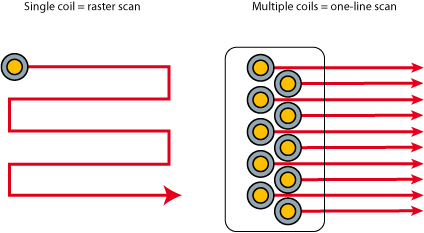基本概念

Eddy current array and conventional eddy current technology share the same basic principle. Alternating current injected into a coil creates a magnetic field (in blue). When the coil is placed over a conductive part, opposed alternating currents (eddy currents, in red) are generated. Defects in the part disturb the path of the eddy currents (in yellow). This disturbance can be measured by the coil.
Eddy current array (ECA) technology provides the ability to electronically drive multiple eddy current coils placed side by side in the same probe assembly. Data acquisition is performed by multiplexing the eddy current coils in a special pattern to avoid mutual inductance between the individual coils.
Most conventional eddy current flaw detection techniques can be reproduced with an ECA inspection. With the benefits of single-pass coverage, and enhanced imaging capabilities, ECA technology provides a remarkably powerful tool and significant time savings during inspections.
Major advantages of ECA testing are the following:
Larger area can be scanned in a single-probe pass, while maintaining a high resolution
Reduced need for complex robotics to move the probe; a simple manual scan is often enough
Improved flaw detection and sizing with C-scan imaging
Inspection of complex shapes using probes customized to the profile of the part being inspected
The OmniScan™ ECA test configuration supports 32 sensor coils (up to 64 with an external multiplexer) working in bridge or transmit-receive mode. The operating frequency ranges from 20 Hz to 6 MHz with the option of using multiple frequencies in the same acquisition.
